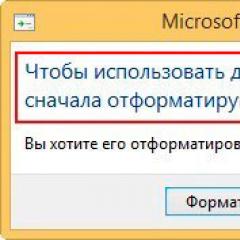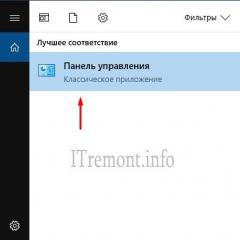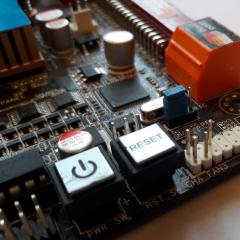How to open the Windows Control Panel. How to open the Windows Control Panel Windows 10 Management
Many Windows 10 users are wondering where the control panel is located in this system, and if previously it could be launched through the context menu of the start button, then after the release of the latest Windows 10 v.1703 (Creators Update), Microsoft developers decided to remove this menu item even from there.
But you shouldn’t get upset right away, because there are a lot of ways to get into the Windows 10 control panel, which we’ll talk about in this article. I’ll also tell you how to return the control panel to its usual place, namely in the context menu of the start button. And I also advise you to read the article How to add a new item to the Windows desktop context menu, which describes an example of adding a control panel. For instructions on opening the panel in other versions of Windows, read the article How to open the control panel in Windows.
The first thing that comes to mind when asking the question where is the control panel in Windows 10 is turning to the system search. To do this, click on the magnifying glass icon located next to the start button, where in the search bar we enter the name of the file we are looking for, in our case it is the control panel. Next, launch the found application.

Launching the Windows 10 Control Panel through the Settings tab
Although the developers are trying to force us to work through the settings tab, you can also get to the control panel through it. To do this, go to start -> options.

Where also in the search bar we enter " control Panel" and open the found item.

Opening the control panel via the command line
Of course, there is always the option to use a specific command to launch various system programs and applications. To open the control panel, there is also a specific command, this is the command " control". It can be entered in the dialog box " execute", which is launched by pressing the key combination +r, also on the command line windows powershell, which is in the context menu of the start button. In both cases, we get to the Windows 10 control panel.

It is advisable to run Windows Powershell as an administrator.


And of course, at the very start, going to the folder official you can launch the control panel.

You can also simplify your task and simply copy the file responsible for launching the control panel to your desktop. To do this, go to the system folder along the path C:\windows\system32\, find a file called control.exe and copy it to the desktop, launch it and rejoice.

Returning the control panel to the context menu of the start button
In the screenshot below, you can see the picture before and after updating Windows 10. Where the control panel has changed to the settings tab. Now let's try to return the panel to its rightful place while maintaining the parameters tab. To do this we need to download a small program called Win+X Menu Editor.

Go to the developer's website using the link http://winaero.com/download.php?view.21, where we download this application. Unpack from the archive and launch. In the main program window, select the tab group2, then click add a program -> add a control panel item.

Find the control panel and press the button select.

Then you need to press the button Restart Explorer to restart Windows Explorer and apply the changes.

Now open the start context menu and see the item that appears. If this item does not appear, try restarting your computer.

I hope you no longer have the question of where the control panel is in Windows 10.
ABOUTGive your opinion about this article, and of course, ask your questions if something suddenly goes wrong for you.
Thank you for your attention!
Where to find ?
This is the first question that arises for a person who has just “sat down” Windows 10. In fact, everything turned out to be simple. Let's consider several methods:
- First way:
He's the fastest. There is such a thing - hot keys, when pressed, certain programmed events occur. To open the control panel just press button combination Win+X(a menu will open on the left, in which there is a control panel item, there is information in the figure below).
- Second way:
You need to move the mouse cursor over the Start icon and press RMB (right mouse button). A context menu will open. Select the line you are interested in. That is, when performing the second action, a menu will also appear, just like the picture above.
The first two methods provide access to many sections of the system.
- Third way:
Control Panel in Windows 10 can be found through the built-in search that is present in every OS. The only thing that has changed is accessibility.
Now just click icon magnifying glasses on right from the “Start” button (or simply press the Win+S key combination). A window will open - enter the query “Control Panel”, the following menu will appear:

- Fourth way:
Place the icon on your desktop. So, the necessary panel will always be “at hand”. To do this, on an unoccupied area of the desktop, click the right mouse button.

In the list that opens, find "Personalization" item. Then click on “Options”, go to “Themes”, where we will need the “Desktop Icon Settings” section.


This is all. A button has appeared on your desktop.
- Fifth way.
Easy access to the PU will be provided by the presence of a corresponding icon on the taskbar and home screen. To do this, you need to go to the Start menu, then go to All Apps.
There you will need a folder " Utilities - Windows" Place the cursor over the “Control Panel” application and right-click on the mouse. Now all that remains is to choose the place where the icon will be located.

What does the control panel contain?
Control Panel in Windows 10 practically no different from the similar one in Window 7 or Windows 10. There are standard sections:
- System and security - the ability to check the status of the computer, archive data, and access the settings of a standard firewall - a firewall created to protect the system from outside intrusion.
- Network and Internet - access to communication settings between computers, or the World Wide Web.
- Equipment and sound – adding devices, sound card settings.
- Removing programs.
- Accounts – create new ones, edit old ones, set passwords, select the administration level.
- Design and personalization - choosing a Windows theme (skin) and resolution.
- Clock, language, region.
- Accessibility – recommended settings, image optimization.

As you can see, a person familiar with older versions of the Microsoft OS will not have any difficulty operating control panels in a modern operating system.
All the same functions and capabilities. So, to summarize, we can come to the conclusion that the main problem is the location of the control panel.
The presented methods for finding it will help you get used to the new “OS”, saving the nerves of a large number of users.
There is a tendency according to which, when the market is replenished with another “OS”, all programs, applications and games are produced focusing on this innovation. Therefore, switching to using a new generation OS will be the right decision.
The main issue is getting used to a different interface, and simply not knowing where the important sections of Windows are located. I hope you were able to figure this issue out. Sincerely, .
The Control Panel in Windows 10 can be divided into two parts: “classic” and “updated”. Which one you use and which one you like – choose for yourself. We suggest reviewing the features of each of them in this article.
So you updated to Windows 10 and began to study its scope. Go to the “Options” item. There is a set of tools that were not present in previous ones. This is enough for ordinary users. If you are an experienced user and want to customize Windows for yourself, but there’s one “but” - you can’t find the same button that was in Windows 7. “How to open the control panel in Windows 10?”, you ask. Here we will explain how to find it in Windows 10.
How to open control panel in windows 10?
First way
A very easy option on how to go into detailed settings in Windows 10.
- Press the key combination “Shift+X”, or right-click on “Start”
- We find the treasured key in the list, and voila!
How to access the control panel in windows 10?
Second way.
How can I call it differently? The most logical thing that comes to mind is to use search.
- Click on the “Magnifying Glass”, which is located next to “Start”.
- Enter the query you need.

There are a lot of other functions in the called line that are not in Start, so don’t forget about this line and use these functions.
How to find the control panel in windows 10?
Third way.
Using this option, you can display this icon on your desktop.
- Right-click on the desktop.
- Select “Personalization” A window will open.
- There, click on “Themes”.
- "Desktop Icon Options"
- A window will pop up, check the box next to “Control Panel”
- Click "OK". There is now an icon on your desktop.

Fourth method.
This option will pin the Control Panel icon to your Start screen and taskbar, making it easy to open.
- Go to “Start”
- "Service - Windows"
- Right-click on “control panel”
- “Pin to Start” and “Pin to Taskbar”

Fifth way.
Another variation of opening is a command that is entered into the “Run” menu.
- Press the key combination “Win + R”
- Enter the command “control”

All possible variations have been outlined to help you find what you need. Thanks for reading the article, good luck!
Good day to all! In many of my notes, I often have to explain how to open the Control Panel in Windows 10. No matter how Microsoft tries to drag all system settings into the Settings window, many users (especially for those who are already accustomed to the standard arrangement of elements) you just need to access the classic Control Panel. And many settings have not yet migrated to “Options”.
There are several ways to open the control panel - I will try to list the most convenient ones (which beginners will certainly appreciate)
Today we will look at a lot of different ways to access the control panel - this is through Explorer and we will use the command line (as is the case with).
Option 1: Start Menu
Open the Start menu and type “Control Panel” in the search bar. Click on the desired item in the search results - that's all!

Many users underestimate this innovation in Windows 10 - the search is implemented very conveniently, be sure to try using it... it really helps when you have a lot of installed applications.
Option 2. Shortcut to Control Panel on the desktop
In one of the previous posts I wrote about, so who is stopping us from creating one for the Control Panel? You just need to know what exactly to specify when creating a shortcut.
Explorer shell:ControlPanelFolder

For the most lazy people, there are special programs with sets of the most popular shortcuts that can be created in one click - if interested, write in the comments. We'll definitely consider it.
Option 3. Explorer
Another easy way to quickly open the Control Panel in Windows 10 is to use File Explorer (as is the case with). Open Windows Explorer and look for the down arrow to the left of “This PC.”

In the drop-down menu you can select “Control Panel” (and many other useful shortcuts)
Option 4. Parameters
From the Start menu, open Settings and type Control Panel in the search bar.

You will see the element you need. Just click on it to open Control Panel.
Option 5: Command line
Launch Windows Command Prompt and type control and press Enter. The command line will open...

This command also works in the Run window, which is accessible by pressing WIN + R (Perhaps this method is more justified than the command line)
Bottom line
After reading, you learned how to open the Control Panel in Windows 10. As you can see, there are several more ways than you expected to see. In fact, you can still drag the shortcut onto the desktop in another way and there are many more different options. If you know some very convenient and unknown to me way to access the control panel, write in the comments, we will definitely add it to the note.



